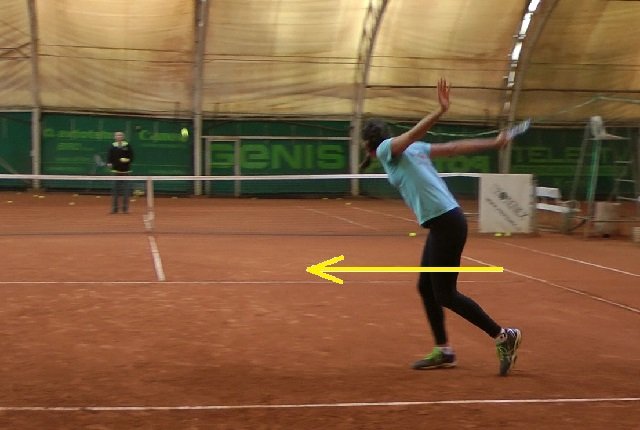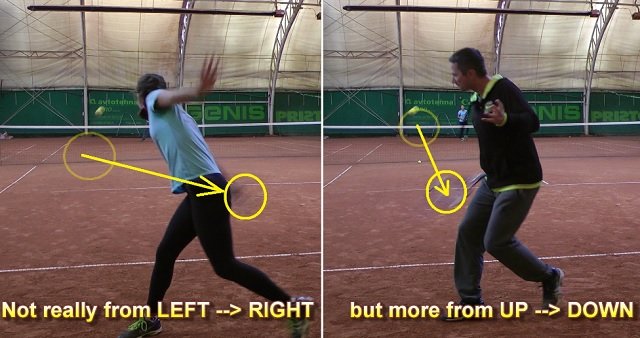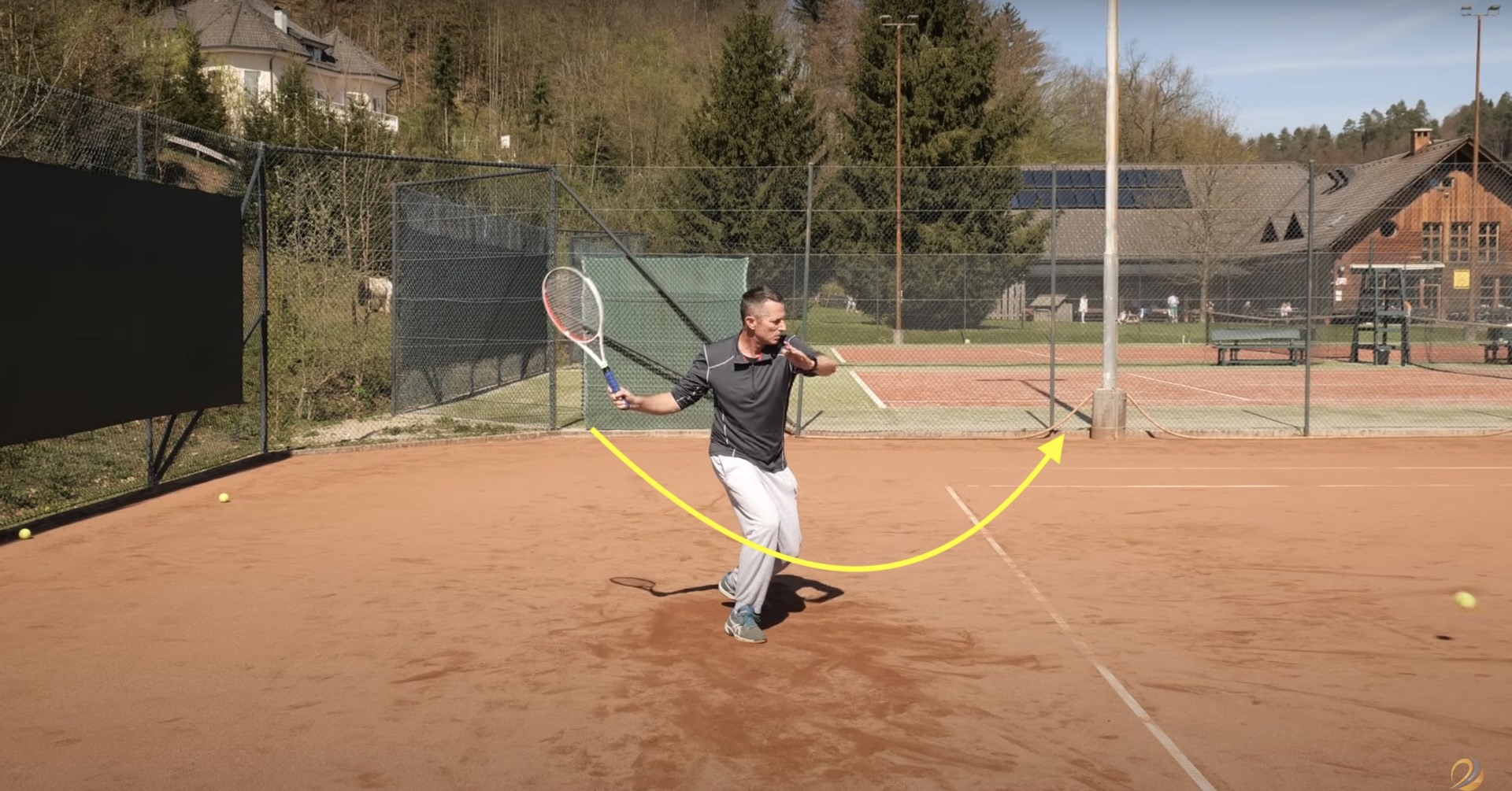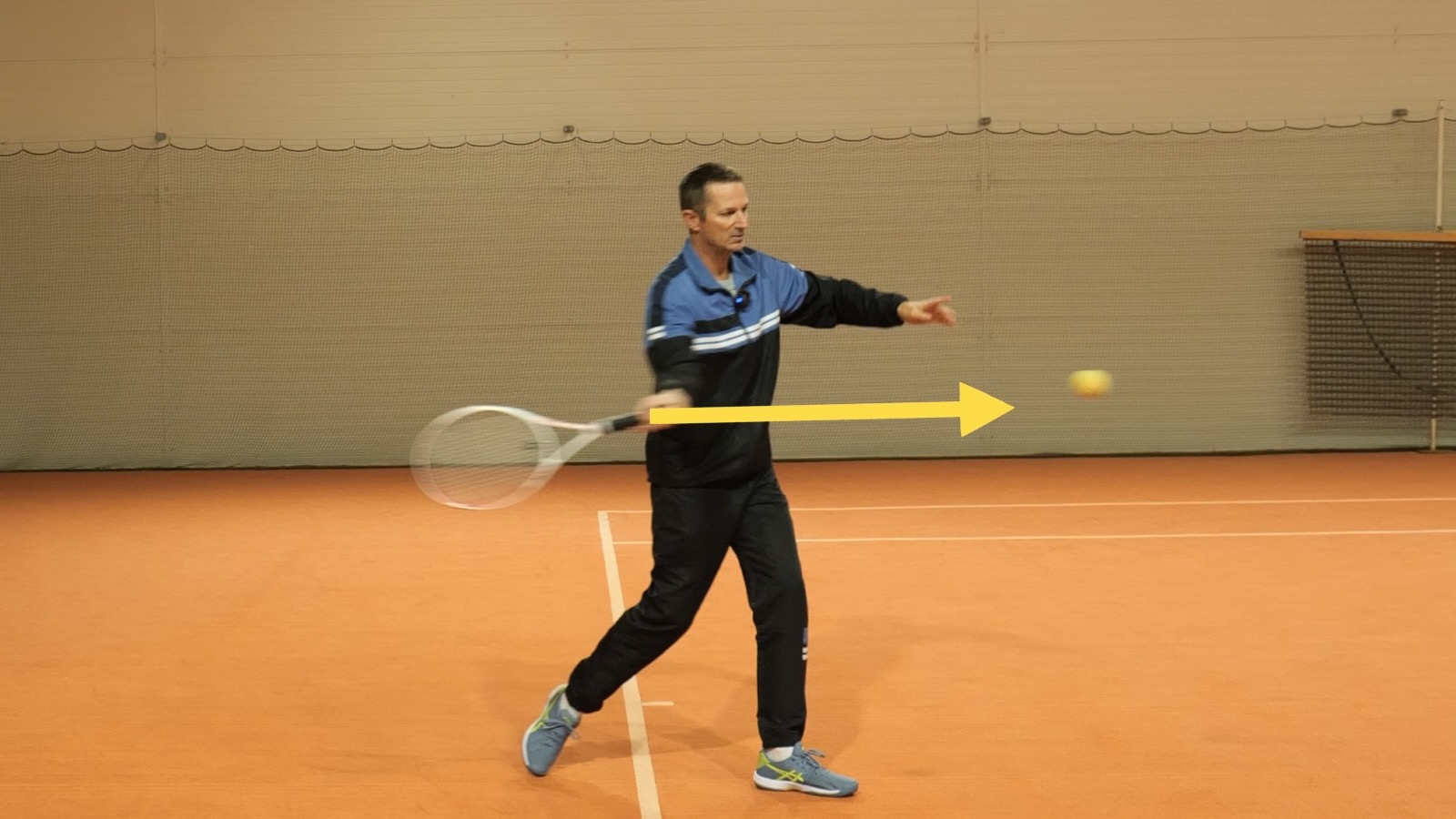The backhand slice stroke in tennis is a great stroke to have to change the rhythm of the game and to play effective, neutralizing shots from defensive situations.
But often times, the slice shot floats too much and therefore bounces too high with not enough speed, which gives your opponent enough time to set up for the shot and continue to dictate the point.
The backhand slice technique requires a certain mental discipline as we need to stay sideways through the shot longer than usual.
This technique is especially difficult to acquire for those players who otherwise play a two-handed backhand stroke where they, of course, have to rotate their body as they execute the stroke.
Since their body is used to rotating and they are used to getting power from rotation, they usually keep rotating somewhat even when hitting a backhand slice. That unfortunately causes their shots to float too much as the racquet path through the ball is not correct.
I’ve been working with Thea on the backhand slice technique recently. While her slice is not bad, it lacks penetration and doesn’t really bite through the court.

Thea hits a nice slice but it's not really fast
She manages to defend from difficult situations, but since the slice is too slow, she often ends up in defense again and finds it difficult to turn the tables in the rally in her favor.
Her slice is fairly consistent, but it floats a little bit too much. She also tends to turn her head a lot immediately after contact and she also turns her body quickly towards the court.
When we compare her slice technique with my backhand slice, you can see much more clearly the differences – namely the direction of the shoulder axis and the head orientation.

Note the differences in shoulder orientation and head orientation
The main two reasons for her over-rotations are:
1. She is used to finding power from rotation as she plays a two-handed backhand where she constantly turns her body during the stroke. Since she hits 90% or more of her backhands with two hands, she gets very used to that rotation.

Thea needs to rotate on the two-handed backhand but stay sideways on the slice
2. She may be anxious to see what happens with her stroke and therefore turns her head quickly, which in turn also pulls her shoulders. That’s actually more of a mental cause rather than just technical.
In order to correct her backhand slice technique, we need to address the technical and the mental causes; otherwise, the problem will persist.
3 Drills For Backhand Slice Fundamentals
The following tennis drills are not only corrective exercises for the backhand slice but also my usual drills for teaching proper backhand slice technique in the first place.
1. Walking through the slice
In this drill, I ask Thea to continue walking across the court and to pay attention to her body orientation which should be at all times in the direction of the walk.

Because Thea keeps walking forward she would find it difficult to rotate
Because she is walking all the time, she would find it quite difficult to rotate through the shot as it’s much more natural now to keep the body facing to the side.
While she still turns her body slightly, she is getting the feel for this drill and in combination with the next two drills she can feel the right way to generate power without turning her body.
She can hit 3 balls in one go and then repeat the drill. We did this for about 30 balls at once.
2. Hitting backwards
This drill exaggerates the feeling of hitting a backhand slice. Namely when we hit the slice, our body is facing 90 degrees away from the direction of the stroke.

Proper technique of the backhand slice is when we remain sideways after contact
Since Thea over-rotates and actually wants to face the direction of the stroke too early, I over-correct her and ask her to hit backwards.
That way, she starts to develop a new feel for how she can generate power in her body even when she doesn’t rotate the hips and shoulders.
She positions herself in a normal neutral position for the backhand slice and hits a few usual shots over the net from my drop feed.
Next, I drop the ball slightly closer to her and ask her to hit to the side fence behind her.

A very effective drill to correct over-rotation on the backhand
We alternate this hitting pattern a few times so that she can transfer the feel of “hitting backwards” to the strokes where she hits normal shots over the net.
This is also a very useful correction drill for the one-handed backhand stroke in case the player happens to over-rotate.
3. Hitting downwards
Most players think of a backhand slice as a very horizontal and circular stroke when in fact it’s a more downward and linear stroke through contact.

Swing path differences on the backhand slice
Yes, pro players very quickly turn their shoulders after hitting the ball, and that may deceive us into thinking that we need to rotate through contact.
But when it comes to the fundamental technique of a backhand slice stroke in tennis, we don’t rotate through the hitting part.
There is no body rotation on the backhand slice
The pros are also such masters of the racquet that sometimes they do intentionally rotate through the stroke in order to impart side spin on the ball.
However, if your fundamentals are not in place, then this advanced slice technique won’t work for you.
In order to give Thea the feel of hitting the ball properly, I ask her to hit slice backhands very close to the net and hit them downwards.

Probably the most important drill for developing good backhand slice
At the same time, I am asking her to stay sideways and hit diagonal shots which again gives her the feel of hitting “backwards”.
There are two more cues that I give her:
- pull your shoulder blades together and
- stretch your chest muscles.
This again leads her in the right direction of engaging her body bio-mechanically correctly, which generates a lot of power without body rotation.
As she starts to feel the power and starts to trust the stroke, she’ll be able to let go of the desire to turn and the desire to look too quickly after her stroke to see what happened.
The one drill that I didn’t show in the video above but we also did quickly in a previous training session was the biting backhand slice drill which I already posted before.
The tricky part when it comes to the backhand slice is that we often play it in defensive situations and are therefore anxious to get out of them as soon as possible.
This anxiousness causes us to try to see very quickly what happens with our slice. In the process, we rotate through the stroke, causing it to float.
Therefore, we must develop the mental discipline to stay sideways through the shot until we feel that we have completed the follow-through.
Only then can we hit a penetrating backhand slice stroke that will neutralize our opponent and prevent the next attacking shot.
Want Even More Backhand Slice Drills?
I have compiled another video of backhand slice drills with Thea where we worked on:
- correcting over-rotation
- better weight transfer into the ball
- better balance
You can access this bonus video by sharing this page with your friends.
In the end, I’d like to point out that you’ll improve your backhand slice technique only through repetition of these and other similar tennis drills that ingrain new movements into your subconscious – and not by reading theoretical analysis of the slice technique.
So try these drills out, they usually work very quickly to give you a new feel for how to hit a proper backhand slice.
But in order for you to stop thinking about the slice technique you’ll need to repeat them a few times…





I think there is some rotation in the slice backhand but it is rotation into the ball and not our of the ball. the r. shoulder blades are orientated somewhat towards the net or the back is turned towards the net and the body rotates into the shot. But at the contact the rotation is stopped and that is the purpose of Federer’s left hand going backward so much. IMO this rotation is necessary for power and bite. But the rotation stops and the racquet comes out as you describe. Sometimes in teaching the bh I demonstrate stand facing the back fence, which is an over exaggeration of the shoulder turn but when they see it from there they can see the effortless of the arm which almost reacts as a pendulum being slung from a rotating shoulder and the work and power of the body.
Thanks for pointing this out, kh. It seems so obvious to me that I never mentioned it.
Of course there is rotation INTO the slice.
It’s just that at contact and slightly later we need to hold it.
In my experience players don’t really have a problem of NOT turning into the slice, they usually keep turning through it.
Great Video Tomaz.
I just came upon another video a few months back on youtube elucidating the same correct backhand slice technique.
I went to the court the same day and was pleased to see the same changes in me, as we see here with your student in a very short time.
I was losing my slice altogether in recent seasons focusing on improving my single handed backhand technique. This disappearing slice stroke started to concern me as less variety was creeping into my game.
When I found the video above and practiced it, I realized I never really had the correct technique in the first place. It is like a breath of fresh air to discover the deep penetrating slice shot from the “new” technique.
Your video today more in depth and perfect timing to deepen the drill and practice in this area of my own game.
Tomaz the Slovenian Wunderkind Teaching Maestro also finds yet another visual venue of interest at which to film one of his instructional videos.
Stay Calm and Slice On,
Richard 🙂
Hello Tomaz, excellent video: very simple, instructional, very nice edition, etc.
The slice, in my opinion is only a colloquial definition (with exception in a drop), perhaps the correct definition is underspin backhand and is a very useful stroke in offensive and defensive situation, for approach is a key stroke.
Thanks Tomaz, is a pleasure as always.
Marcelo from Argentina.
Thanks for sharing, Marcelo!
I use the word “slice” perhaps too commonly because in Slovenian language we almost never use anything similar to “underspin backhand”.
Apologies Tomaz, at no time wanted to highlight the semantic “slice or underspin”. In Argentina also we used the word “slice” even when speaking in Spanish.
I just tried to mention the concept of “underspin”, perhaps because it is more graphic conceptually, especially in contrast to topspin.
Language problems …….
I congratulate you and thank you for always virtual classes you offer us. Too bad we’re a world away to take a real class.
Greetings.
Marcelo
Thanks, Richard!
The backhand slice stroke is sometimes tricky because we feel good power source in body rotation but in this case we must not use it. 😉
We must find another way which is not so obvious at first glance – and that’s pulling the shoulder blades together. That gives us power and clean hit.
I found it very useful
Thomaz, Really impressed with all your videos and teaching methods.
As a ex squash player the backhand slice is easy for me, I always think “High to low” and bite the ball, also I feel that I am hitting the ball later than a topspin shot.
Cheers!
Daveg
Good points, Daveg!
Experience from other sports is often very beneficial since we can make easy analogies and transfer skills between them.
Very helpful video, Tomaz. Your strategy and technique videos are consistently right on target and, in my opinion, are among the very best to be found on the internet.
Besides the ability of the slice backhand to change the pace of an exchange and neutralize the aggression of the opponent, I find that club-level players often mishit their returns of this shot (probably because it bounces lower than they expected). It is also a great shot to use when receiving a fast serve to the backhand side as the stroke utilizes a shorter backswing than the drive.
A couple of tricks I use to help boost the quality of my backhand slice: (1) be sure to take the racquet head back sufficiently high so the forward swing has a definite downward path. This prevents a mostly lateral movement of the racquet which encourages floaters.
(2) Stepping forward and planting the outside foot just as the ball is struck insures that your weight properly shifts forward at the correct time. Good weight transfer helps give “sting” to the shot.
I believe Ken Rosewall developed the backhand slice to perfection. It was his dominant backhand stroke and he could aggressively knife his return close to the lines, winning many points that way.
Cheers,
George
Much appreciated, George, really good tips!
..and I thought I had a great slice!!!
No wonder my slices were
-floating and going away from my right handed opponents’ forehand.. —were landing inside the service box as drop shots..
Now I understand that it’s because of me going left to right instead of top to bottom as demonstrated. I was also opening up my shoulders. Really eye opening technique on my favorite shot and I can’t wait to hit the practice courts.
Many thanks Tomaz for this MASTERCLASS! Brilliantly done.
You’re very welcome, Vivek. Try a few drills from the video so that you get the feel for the slice rather than just sticking with the theory…
Hi Tomaz,
I always like your tips – this one particularly because we can see how you work! Still some remarks:
Here my ideas…
I don’t think she is much too open in the moment when hitting, I actually like her left arm action going behind; of course it is great to leave the head still at contact – like Roger!
Still here it is a question about getting more “bite” into the shot (I actually remember you offering an exercise in Singapore):
1. She would get it by stepping more into the ball (weight-transfer!) – look at the position of her front foot compared to yours – she blocks more.
2. she leans in a bit too early, especially on the lower ball.
3. If she goes a little bit too much „high to low“ she takes too much pace off the ball, the ball floats; the same if the racket is too open (difficult to see on your film), she should just be a little bit above the plane of the incoming ball with the racket.
4 I think -she allows the ball to drop too much from the apex and loses speed.
5. Does she have a firm wrist?
6. It helps to aim for the outside of the ball (= more solid contact)
7. Actually a follow through towards the target – could also help more (I guess that is your point).
I still like your exercises and ideas. Thank you!
Thanks for your ideas, Peter.
Firstly, even though I agree with some of your points, I did not tell her that in that session.
The article above is not a complete guide on the backhand slice but 15 minutes of one training session demonstrating how effective some drills are in improving the slice.
Secondly, one of the most important things when correcting or teaching is not to overwhelm the player with the information.
So she received only 3 bits of information last time and yet today when we checked the backhand slice, she couldn’t find for a minute or two.
After we refreshed her memory and feel, we added a few more exercises like going more into the ball and adding another drill that prevents rotation (the karaoke step).
I only add more information when I see that the first bits of information are not taxing the brain that much.
Another thing that guides me is the ball.
It might be hard to see how she hits the ball in 2D here but in reality the slice is really good now.
I always look at the ball first and not on technical details.
If the ball is so good (and it is now), then technique cannot be incorrect. It’s the laws of physics.
In time though as she plays more and more slices she will become more comfortable with it and she will discover the little nuances of the stroke that will actually eliminate the last technical details.
In other words she will self-correct subconsciously since she now knows what the right ball feels like.
I know that many coaches don’t believe in self-correction but I learned to play with almost perfect technique in all strokes without having one single lesson in my life – so I (and my friend Urban and many others) are perfect examples of what I am talking about.
Hi Tomaz,
thank you for your answer, I also do believe in selfcorrection and I do love your approach with “feeling” and so I agree with you: not too much information at once!
What strikes me is the fact that you see even Federer opening up ( and Wawrinka of course) when hitting backhands because they add sidespin to the ball, and it is true from physics, that takes power away.
Thank you again for sharing your great work!
Thanks for the instructions. I just started utilizing a backhand slice to my repertoire. Your video has made it easy for me to establish a very powerful slice immediately. It makes a lot of sense to open the chest and pull the shoulders blades together and hit it. I’ve never tried to hit a true slice so I don’t have any bad habits to get over. Its nice to also be able to get out of defensive situations with this and I’m sure my confidence will go up greatly. I’m very happy I’ve found you. Thanks again for all your instructional videos.
You’re very welcome, Kalani, stay in touch.
Thank you Tomaz for the great article again. I have always had an inconsistent backhand slice. It seems like the easier the ball I get, the more it floats up on me. The ones that I hit extremely well with tons of bits are the ones that I am totally stretched out on a defensive run. I now know why I hit those ball better under that circumstance. The hitting more downward with the inability to make a big shoulder turn was the difference.
Time to work on those same technique for all balls. Thank you!!
Thanks, Matthew. Yes, it happened to me too that when I was figuring out my backhand slice I also realized that my best shots were actually the ones at full stretch.
That’s because we can’t rotate the shoulders at that time but also because we hit the ball away from the body which allows for proper swing path.
This comment has nothing to do with the slice but on my serve. I use this hitting from behind technique on my serve by opening my chest towards the back fence when doing the trophy pose then pronating my racket upwards when hitting up on the ball . This prevents me from too quickly looking at the opposite side of the court or the net . I also like to say with balance I feel more stability going from leaning forward on the front foot then backwards on the back foot when getting ready for the trophy pose. It put ls the stability in my serve by knowing the back foot is there when hitting up from the trophy pose . I will look at the ball now than the court or net .
Thanks, Francis, good points!
Great videos. Appreciate the detail and teaching skill.
Wow, this was my exact problem. I fixed it. Thank you so much. It feels great. Glad I stumbled onto your website from google.
Do you have some videos on how to stop framing one handed backhands when trying to hit cross court? My down the line is very good. I’m forced to dial down while hitting cross court to not frame it, and it ends up being a weak shot.
Hi tennisfan,
Here’s an article that may help you in case of framing shots:
https://www.feeltennis.net/why-your-strokes-lack-power/
So you may be pulling away from contact too early as you are turning towards the cross court direction. Just delay it a split second but make sure you are hitting a cross court more in front than the down the line.
https://www.feeltennis.net/cross-court-down-the-line/